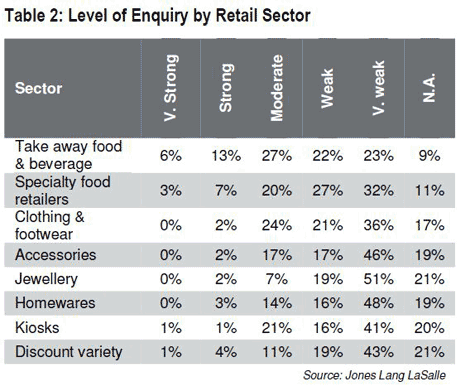Retail centres need to change tenant mix to improve performance: Jones Lang LaSalle
Retail centres should be changing their tenant mix to improve performance over the next 12 months, according to the latest report by Jones Lang LaSalle.
Jones Lang LaSalle's Retail Centre Managers’ Survey found the key factor expected to improve performance of individual retail centres over the next 12 months is a new tenant mix.
“Those retail centres that have deliberately changed their tenancy mix or attracted new tenants with strong customer appeal have reported solid growth during a challenging trading period,” says Richard Fennell of Jones Lang LaSalle.
“With clothing and footwear continuing to struggle, sub-regional shopping centres are re-focusing their tenancy mix to better reflect the needs of their catchment and growth sectors. This includes specialty food, dine-in cafes/restaurants, and a range of services that bring repeat customers to the centre.”
He says the ability to improve tenancy mix is constrained by limited demand and the need for injection of capital before tenants commit and recommends alternative lease terms and tenant incentives.
“Alternative lease terms are being considered in order to accommodate new or struggling retailers. This may include shorter lease terms and percentage rent deals. Centre managers have also reported some rent reversion at the end of the lease period in order to retain tenants,” he says.
“There is also a higher expectation on the part of tenants for incentives. These include both rent-free periods and fit-out contributions, with tenants having limited capital to cover the cost of fit-outs.”
Vacancy rates increased slightly from 4.2% in December 2011 to 5.1% in March 2012 for neighbourhood centres and from 1.1% to 1.4% in March 2012 for sub-regional centres.

Tenant enquiry improved slightly, but from a very low base. Enquiry remains weak, with food retailers and the discount variety sector (in sub-regional centres) showing the main interest.
The report found the average rental growth for neighbourhood centres was 2.8% for the year ending March 2012. Sub-regional centre growth has been weaker, averaging just 1.3% over the 12-month period.
Sentiment in retail centres across Australia had improved slightly following the Reserve Bank’s cash rate cut in May. The report was published before June’s further rate cut.
According to the report, 57% of centre managers expected some growth in sales over the next 12 months, up from 49% in February, though their sentiment is described as “caution optimism”. Those in the 57% primarily expect growth of less than 3%. Those expecting sales to decline fell from 31% to 21%.
Research director David Snoswell says the Reserve Bank’s 50-basis-point cut in the official cash rate in May is the main reason for improving sentiment among centre managers.
Despite the positivity of centre mangers consumers remain cautious, with the Westpac-Melbourne Institute Index of Consumer Sentiment showing no recovery in May following the rate cut.
“Cautious consumers are going to be wary of spending the savings from lower mortgage payments on retail goods, at least in the short term,” says Snoswell.